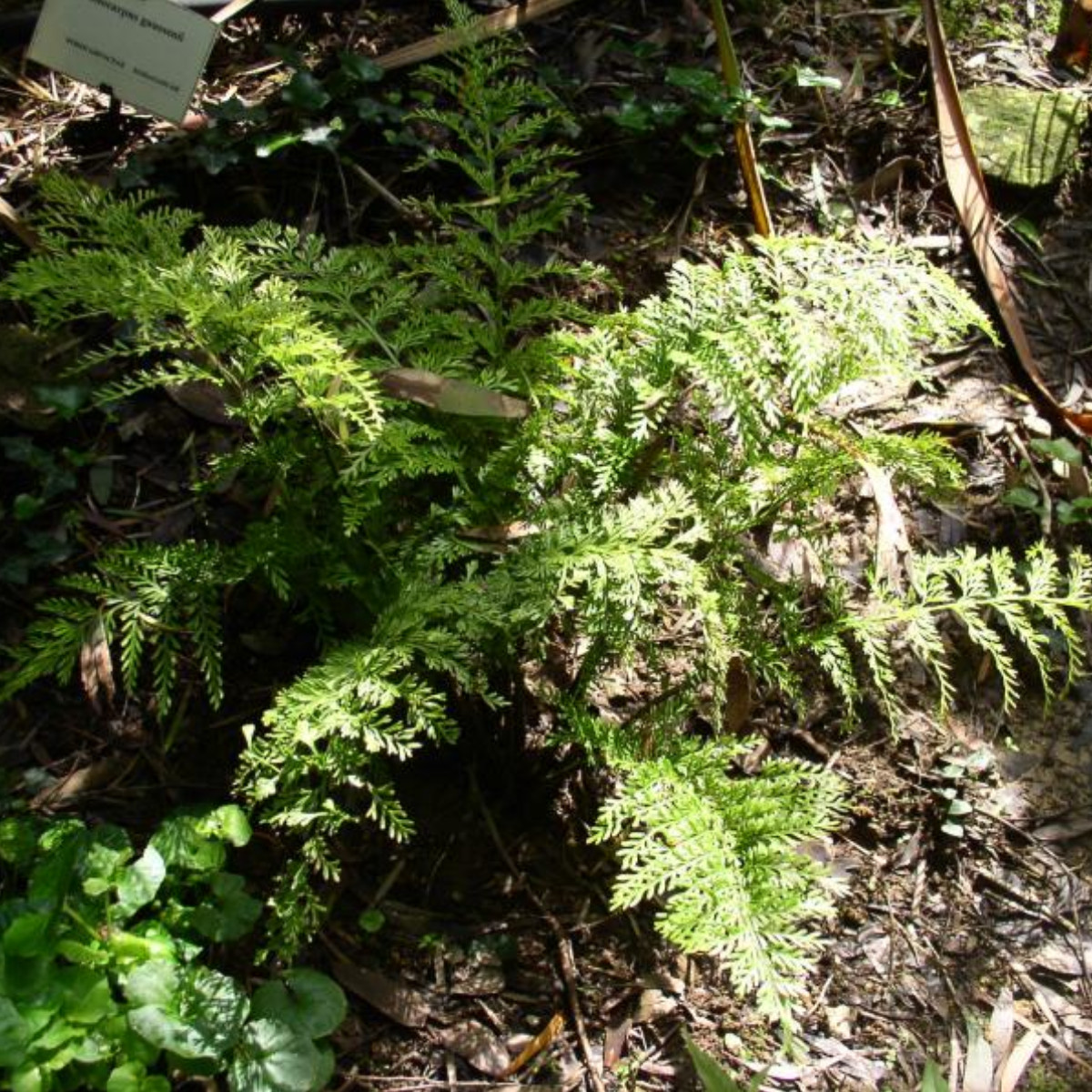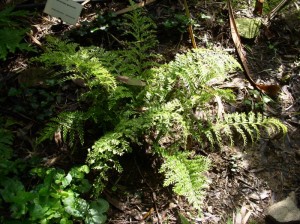Family: Aspleniaceae
Synonymous: Asplenium bullatum
Asplenium cavalerianum
Asplenium marinum var. bulbifera
Asplenium viridissimum
Caenopteris bulbifera
Distribution and habitat: Asplenium bulbiferum is an evergreen fern species native to Australia and New Zealand. It grows in a diverse range of habitats along stream banks, in rainforests, in lowlands, in alpine regions, along coast lines. It is invariably associated with flowing water, close to permanent creeks and almost always with waterfalls.
Generally Asplenium bulbiferum are terrestrials (growing in the ground) but sometimes are epiphytes (growing on hosts such as trees).
Description: Asplenium bulbiferum has foliage that closely resemble carrot leaves, but the medium green fronds are studier and more finely divided than those of carrot leaves. They are up to 60cm (24 inch) long and 22cm (9 inch) wide and they grow on black stalks. Each fronds is split into between 20 and 30 leaflets. Small brown bulbils from which arise replicas of the parent plant appear on the upper surface of several of the leaflets; these will eventually weigh the whole frond down slightly. Once grown to about 5 cm (2 inch), these offsprings fall off and when touch the moist soil they develop a root system and grow into new ferns. This additional means of reproduction is easier to use for propagation than spores.
The new foliage is a bright green turning darker with age. The fern has a crown and foliage unfurls from it. The fern also produces spore on the underside of the fronds and so it has a double chance to propagate.
Houseplant care: Old fronds can be removed to improve appearance.
It is possible to wire the plant to a slab of wood or to tree trunks
Light:Asplenium bulbiferum thrives in many situations from shade to partial sunlight, including areas with low light. Give them medium light all year long.
Temperature:Asplenium bulbiferum do well in normal room temperatures although they can actually withstand quite low temperatures.
Keep Asplenium bulbiferum away from droughts and direct contact with heat. A temperature between 16 to 21C (61-70F) is ideal with a minimum temperature of 10C (50F).
Stand the pots on trays or saucers of moist pebbles to increase the humidity. Frequently misting the plants is another option to keep them healthy.
Watering: During the active growth period water plentifully as often as necessary to make the potting mixture thoroughly moist.
During the rest period water sparingly, enough to keep the potting mixture from drying out. It will not hurt these ferns to dry out for a while, but it is best to keep them evenly moist.
Feeding: Apply liquid fertilizer to well established plants once a month during the active growth period.
Potting and repotting: Inspect the root ball annually in spring and repot if necessary, using a soil-less compost with added coarse sand for drainage.
Repotting is needed only when the root ball becomes so dense and crowded that the pot is full of roots and obviously the plant is not absorbing enough moisture when watered. When this occurs, move plants into pots one size larger in the spring.
The roots of these plants will often adhere firmly to the sides of a pot and in some cases it may be necessary to carefully break the pot to be able to remove the plant.
Garden Culture:Asplenium bulbiferum is hardy outdoors to zone 9. With very feathery foliage and dense habit it is an excellent plant for cool moist spots in the garden. A place around awater feature is ideal for Asplenium bulbiferum thus the increased air humidity, resembling its natural habitat.
Position: These ferns tend to thrive in shade to partial sunlight, preferringnorth-facing exposures. PlantAsplenium bulbiferum in areas with wind, frost and drought protection.
Bright midday sun may damage the fronds.
Soil: It grows in well-drained or moist but well-drained soil. Amend heavy clay or sandy soils with organic matter.
Water: Follow a regular watering schedule during the first growing season to establish a deep, extensive root system. Water slowly and deeply when plants begin to wilt and do not perk up at night. When possible, water in the morning to avoid promoting diseases from night watering.
Mulches them to help reduce water evaporation in hot or dry weather.
Fertilising: Feed frequently during growing season with a general purpose fertilizer.
Propagation: Asplenium bulbiferum is easily propagated by means of the bulbils that grow on the mature fronds. When the bulbild are carrying three of four miniature fronds, they can be easily detached between the finger and thumb and then planted in small pots.
Place the young fern on the surface of recommended potting mixture for ferns and water them just enough to moisten the mixture. Do not overwater. Enclose each propagation pot in a plastic bag or propagating case and keep it at normal room temperature in a slightly shaded position until further top growth begins to appear.
Thereafter, the best procedure is to gradually reduce the humidity by removing the plastic bag or uncovering the propagating case for increasingly long periods over the next four weeks and water the plant just enough to keep the mixture barely moist. Do not feed the new fern.
At the end of this time carefully move the fern into a larger pot and treat it as an adult Asplenium bulbiferum.
This vegetative reproduction is much easier to use for propagation than by using the spore method.
Problems: Asplenium bulbiferum are rarely bothered by pests. Space out the ferns to allow air circulation as this will assist with prevention of wilting.
They can be troubled by snails and slugs, however, if grown outside. A single slug can devour a whole leaf.
Treatment: Use from time to time a snail bait to prevent or combat snails and slugs, especially in spring when fern develop new fronds.
Asplenium bulbiferum can attract aphids.
Treatment: Sighted spray (use at lowest of recommended rate) the ferns with insecticide.
Asplenium bulbiferum can get Crown rot (growing tip gets mushy) if the ferns sit with too much water in crown especially after long dry period.
Yellowing of fern fronds - in ground ferns often due to over exposure to direct sun.
Treatment: need more shade to allow normal greening to operate. Relocate the fern in a suitable position.
Yellowing of fern fronds - in potted ferns that looks very old and roots are coming through the bottom and fern is struggling probably root-bound with lack of nutriment.
Treatment: Take out from its pot and trim back side roots and re-pot with new potting mix.
Note:Asplenium bulbiferum has a curiosity value for its ability to grow plantlets directly on the surface of the feathery fronds, an amazing adaptation to vegetative propagation along with spore propagation which is normal for ferns.
Uses: Asplenium bulbiferum can be terrestrial or epiphytic depending on how it iscultivated and does very well in pots or hanging baskets. It is an excellent subject for large tubs and pots and becomes quite an impressive specimen given time.
When Asplenium bulbiferum is grown outdoors, the following companion plants can be used to create attractive garden landscape: Ajuga reptans 'Catlin's Giant' (Catlin's Giant Carpet Bugle), Dicentra x 'Luxuriant' (Luxuriant Fringed Bleeding Heart), Campanula portenschlagiana (Dalmatian Bellflower), Hosta and Azalea species.
It has very high moisture needs, thus it is suitable bogs and water gardens situated on draped shade positions.
SUMMARY:
CHARACTERISTICS:
Foliage green
Shape rosette
Height: 60cm (24 inch)
PROPER CARE:
Watering in rest period sparingly
Watering in active growth period plentifully
Light medium
Temperature in rest period min 10C max 24C (50-75F)
Temperature in active growth period min 16C max 24C (61-75F)
Humidity high
Hardiness zone: 9-11





